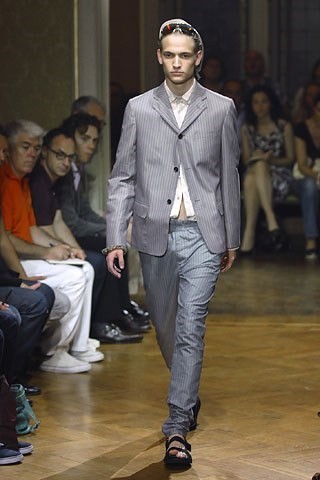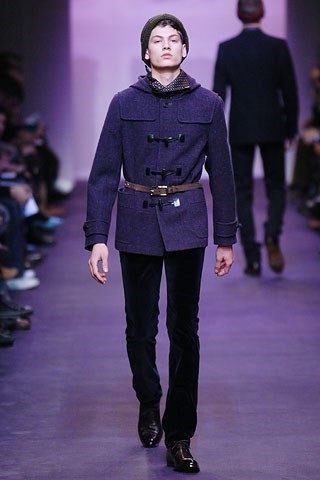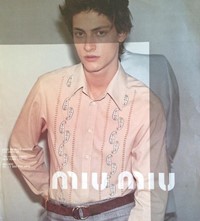In the first part of his new series on obsolete menswear brands, and ahead of today’s Miu Miu show, Rob Nowill remembers the label’s amazing men’s line
- TextRob Nowill
The Ones That Got Away is a new series by Rob Nowill that examines brilliant and now sadly obsolete menswear brands.
Contemporary fashion frequently feels as though it suffers from an attention deficit. There’s a constant, ever-increasing barrage of new drops, ‘must-haves’, and over-hyped collaborations. As a result, it’s easy to forget how many great brands fall off the radar and don’t survive. Financial pressures, fickle editors and the often-challenging demands of retailers have made it increasingly difficult to sustain a business – and a brand’s failure rarely has much to with the talent of its designer. In my list of labels that left the world too soon, Miu Miu menswear, which showed it last (S/S08) collection a decade ago, is at the top.
It never achieved ‘grail’ status with the hypebeast crowd: there are no standout ‘cult’ pieces, it’s never appeared in A$AP lyrics, and prices for it on resale sites have stayed relatively low. But speak to most menswear editors about it, and they’ll get a misty, far-off look. There’s a smugness, too, about owning pieces of it now – in part because it’s so difficult to track the best pieces down.
Although it’s only been ten years since the closure of the menswear line, it might as well be from another lifetime. It’s from the era before Instagram, before influencers, before ‘see now, buy now’. The demands of the social media age have meant that a great deal of modern fashion has been reduced to the level of merchandise. Take a look at many recent runway shows, and you’ll see what I mean: every piece is an attention-grabber, designed to be recognisable enough to draw your attention on a social media feed or an e-commerce site. Everything is piled together, layered up and loaded on. Never mind a single, articulate message: just throw everything at the wall and see what sticks. And it works; as the demand for tailoring has waned, most brands have come to depend on printed tees, slogan hoodies and statement trainers as their commercial bread and butter.

Miu Miu’s men’s collections weren’t about that. Look through the images of their shows and there are no logos, no ‘it’ shoes, no Insta-friendly motifs. Instead, the clothes look almost oppressively ordinary, until you look closer at them. My favourite collection, S/S07, opens with a grey suit. But the trousers are slung low, almost to the hip bone, while the shirt beneath is cropped to reveal a sliver of skin as the model walks. There’s a subtle perversity to the clothes; the sense that there’s more to be revealed if you’d care to look closer.
Its subversions were often achieved with the simplest gestures. For A/W05, the brand took all of the staples of masculine dressing – duffle coats, leather jackets, tailored overcoats – and belted them at the waist. In one sweep, it made everything in the collection look strangely feminised. In Miuccia Prada’s final (S/S08) men’s collection for the brand, suits are cut with ankle-swinging hems, shirts are piped like pyjamas, and shorts are abbreviated to the upper reaches of the thigh. Everything just looks off, in the best possible way.

The menswear was often bracketed with Marni in its aesthetic (as, indeed, the women’s collection still is), as both shared a boyish, bookish look. But I think, in many ways, it was actually more Prada than Prada itself: it was about dissecting masculinity, holding it up to the light, and revealing all of its absurdities. The advertising campaigns (which are some of my favourite fashion images) didn’t play to the whippet-thin, haunted look of Hedi Slimane’s Dior Homme, or the hunks-in-trunks virility of most mid-00s fashion. The models weren’t boys, but they weren’t beefcakes.
There’s no point in eulogising about the way things were. Culture moves forward; if the brand was still alive now, it would doubtlessly have adapted to the social media age to survive. And it’s fruitless to complain about the state of the menswear industry when it has never been in a period of stronger growth. Miu Miu’s menswear clearly never achieved enough commercial traction to survive. Today’s brands have. But I’d hope that the collections serve as a reminder that fashion doesn’t have to signal itself at foghorn levels to be relevant, or interesting, or worthy of attention. Miu Miu menswear wasn’t the loudest voice in the room. It was pitched at a lower key. And it was just good clothes.
Rob Nowill is a writer and menswear consultant who contributes to Guardian, AnOther Man, GQ and Vice















